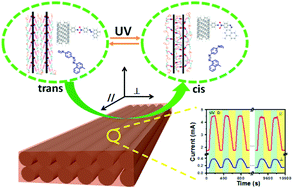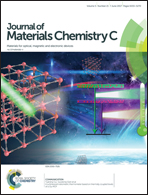The light-switching conductance of an anisotropic azobenzene-based polymer close-packed on horizontally aligned carbon nanotubes†
Abstract
Anisotropic light-switching properties are of great importance in advanced photodetectors, light-gated transistors, and energy storage devices. However, controlling the light-switching conductance of anisotropic materials remains challenging because of the difficulties in tuning the electronic interactions and microstructure in the longitudinal and transverse directions, respectively. We present a transparent and flexible photo-responsive film of azobenzene–poly(methyl methacrylate) (Azo–PMMA) close-packed on the sidewalls of horizontally aligned carbon nanotubes (HACNTs). The alignment leads to an anisotropic electrical conductivity (σ). The aligned composite film shows a steady increase in σ in the longitudinal (σ∥) and transverse directions (σ⊥) during UV irradiation and a continuous decrease after irradiation. The light-switching conductance shows good cycling performance over 25 cycles, which is consistent with the isomerisation of the azobenzene groups in Azo–PMMA. Light-switching conductance is demonstrated in two directions, originating from the light-induced switch to a greater proportion of more conductive cis-Azo isomers, photo-doping and the film contracting during the trans-to-cis photo-isomerisation. The anisotropic Azo–PMMA/HACNT composite film with a light-switchable conductivity paves the way towards the fabrication of anisotropic photo-controllable materials by molecular design and microstructure modulation.



 Please wait while we load your content...
Please wait while we load your content...